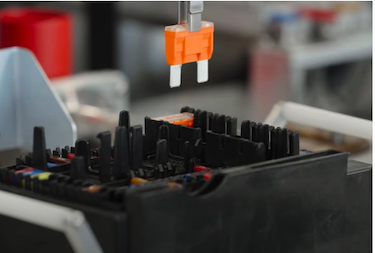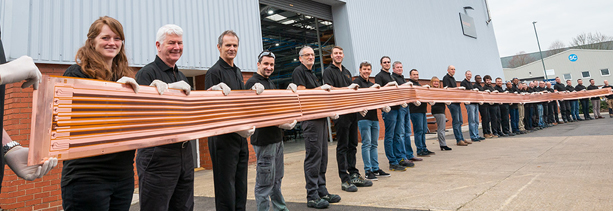Trackwise Champions Improved Harness Technology™
By Joe Tito
WHN has published several press releases covering flexible printed circuits (FPCs). The rational has been to make the industry aware of this technology as a possible replacement of traditional wire and cable harness assemblies for some traditionally wired applications. As we often see in technologies used by large OEMs, there is a trickle down into low-volume/high-mix applications. As such, this article may serve as an inspiration for many traditional harness manufacturers looking to bring new technologies on board. It is also hopeful it will highlight the rationale of involving interconnect suppliers in the design stage of product development.
Trackwise is very much at the forefront of FPC technology at the OEM level in the automotive, aerospace and medical arenas. It seemed logical to delve into their history and learn about the development and future of FPCs that Trackwise calls Improved Harness Technology™ (IHT). The company’s Founder and CEO, Philip Johnston, took the time to sit down with WHN for a fascinating interview.
Founder and CEO, Philip Johnston)
Located in Tewkesbury, UK, Trackwise has been producing FPCs since 1989. Their penchant for large format circuits came with a specific customer request just a few short years into their existence. “In the mid 1990s we were asked to make a nine-foot long flexible circuit for one of the early cellular base station antennas,” Philip recalled. As the frequency of mobile telephony went up, the size of the circuits came down. Nonetheless, Trackwise continued to further develop their large format capability.
Eventually, a large UK aerospace OEM approached Trackwise seeking to replace a harness assembly inside their aircraft engines. They’d seen FPC technology and were looking to reduce overall weight and size. “One requirement was to replace an eight-meter run of harnesses around the engine to be made as a single piece, rather than a daisy chain of interconnected sections,” Philip explained. “Everybody else said it couldn’t be done, but we thought about it and came up with a means of making length-unlimited multilayer printed circuit boards.”
FPC technology has been around since the 1950’s, but it’s this proprietary manufacturing process that puts Trackwise in an exclusive club among FPC suppliers. “Instead of using the technology only within a box, you can now go box to box inside a wing or within a vehicle,” Philip said.
Trackwise has poured a great deal of research into the further development of its Improved Harness Technology™. Philip mentioned the headline benefit being the space and weight savings of up to 70%. Whereas traditional harness manufacturing involves heavy human intervention, FPCs are machine made, offering increased repeatability and dependability. He added that because FPCs are a planar technology, they can be formed under, or even into a composite structure.
Philip doesn’t think traditional wire and cable assemblies are going away anytime soon, and sees traditional wire harnesses, FPC’s and fiber optics working in concert as a combined offering. “At the moment, vehicles, and in particular airplanes, are wired in fundamentally the same way they have been for 100 years. So, I think there is an opportunity for a designer to use different technologies in the right location and correct format to allow greater functionality as we move into smaller form factors.”
The most significant contribution of FPCs, as Philip sees it, is their design flexibility as an active component. “A conventional wire harness is a passive component, but with FPCs, you can add surface-mount or through-hole components allowing the distribution of control, and giving the assembly local intelligence,” he outlined. Instead of feeding signals back to a box, then doing the controls, the controls can be done locally, thus drastically reducing system complexity.
The opportunity window for FPCs greatly increases if the technology is thought of in the beginning and as part of the system, according to Philip. One area he thinks offers great adoption of FPCs is with electric vehicles, especially in the battery management systems (BMS). “The ability to make the interconnect part of the active control of the system must be thought of at the onset. And that’s why I see great opportunities in electric vehicles, particularly start-up OEMs as opposed to companies who are just replacing an internal combustion engine with an electric drivetrain,” he explained. Trackwise is always keen to work with OEMs who are starting with a blank canvas, and are thinking system down, rather than box in.
Like traditional wire and cable harness producers, printed circuit board manufacturers are typically build to print. “We’ve had to change our aerospace accreditation to include both design and manufacture because we are having to offer the design expertise to supplement the skills that aren’t always present with our customers,” Philip revealed. He described a typical first meeting with an OEM. One of the first things that happens is the customer shows them a traditional harness and asks what it would look like in flex. “My heart both sinks and soars,” he detailed. “It soars because it’s great they are interested, but it sinks because I know if it were designed with flex in mind, it wouldn’t look like this bundle they’ve just handed me.” A journey has started with a single conversation, but Philip is keen to stress that the OEMs who are thinking of FPCs at the beginning of system design are the ones who derive the most benefits from them.
There’s a wide range of materials available for the manufacture of FPCs. When they engage a new opportunity, the first thing the Trackwise team seeks to know is where the assembly will be used. “The environment it’s operating in absolutely key to both the design and material selection,” Philip advised. “We’ve developed some harnesses going into 200° C plus environment, and in high vibration zones inside engines, so clearly this can be a very robust technology.”
Other Opportunities for FPCs
It seems obvious that FPC technology is a key enabler for many industries. When asked about more recent opportunities, Philip quickly responded that medical devices are an excellent application for FPCs. “One macro trend in all industries is that designers are wanting to get greater functionality into smaller form factors. We are seeing this in medical catheters where you have tiny traces of maybe two-mil, where the very precise nature of printed circuit technology is allowing us to get greater functionality in these devices,” he outlined.
Philip circled back to the aerospace industry as he expanded on new opportunities for FPCs by discussing multifunctional structures. “With the right material selection, we are actually able to embed the wiring into a structural composite. Again, it’s a planar item, so it can actually go inside the composite structure, which is something that can’t be done with a traditional wire harness.” He pointed out that in this configuration, there is just one structural part with an embedded circuit, versus the structure along with a separate wiring component. He noted innovative OEMs in the automotive industry are also beginning to use multifunctional structures.
In order to meet the demand challenges, Trackwise has raised capital, enlarged facilities, and made strategic acquisitions quite recently. “We actually landed on the London Stock Exchange last July and raised quite a bit of money to invest in our manufacturing capability,” Philip mentioned. A further round of fund raising on the Exchange raised enough capital to allow them to purchase another circuit company in the UK in order to increase capacity. “We were a small company with ambitions to change the way airplanes and automobiles are wired, so having access to public markets gave us the capital to grow with the success of our clients.”
You can learn more about Trackwise and review white papers on FPC technology by visiting www.trackwise.co.uk.

































































